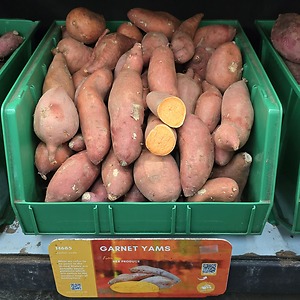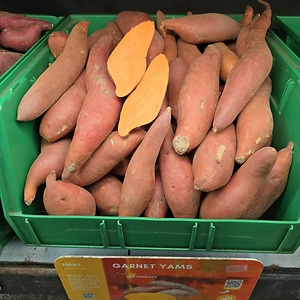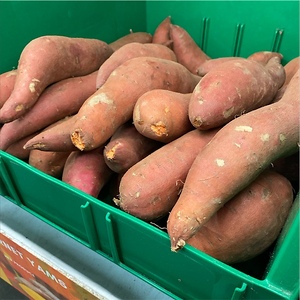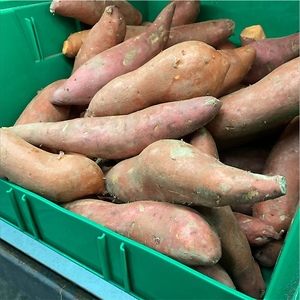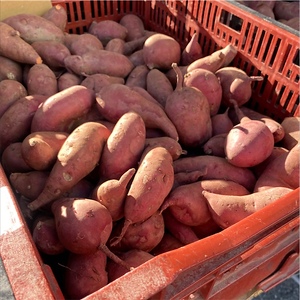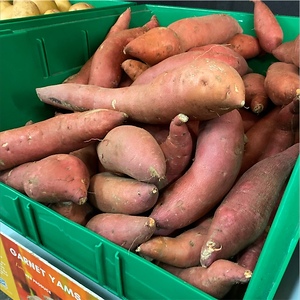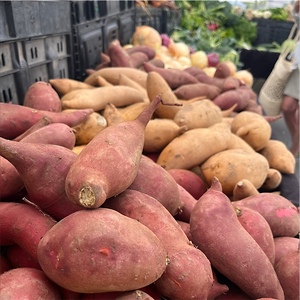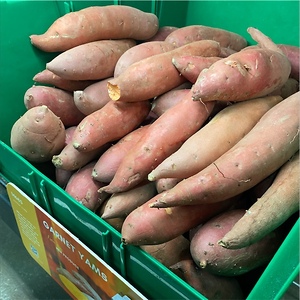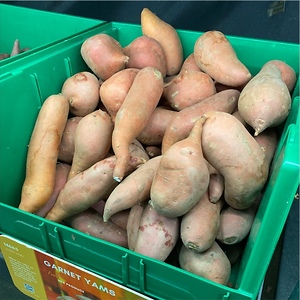

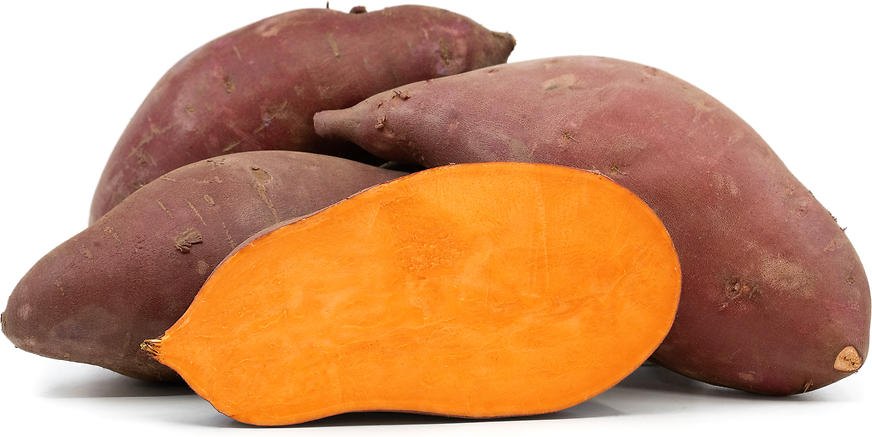
Garnet Yams
Estimated Inventory, 40 lbs : 25.06
This item was last sold on : 07/14/25
Description/Taste
Garnet yams are medium to large in size and are slender, ovate, and cylindrical in shape, tapering at the ends. The rough skin is a dusty brown-maroon with some brown spots scattered across the surface. The flesh is orange-gold and is firm, dense, and moist. When cooked, Garnet yams are starchy and moister than other yam varieties, and its flavor is sweet with a savory earthiness. In addition to the tubers, the leaves of the Garnet yam plant are edible as well, offering both nutrients and a flavor similar to that of spinach.
Seasons/Availability
Garnet yams are available year-round, with peak season in the fall through winter.
Current Facts
Garnet yams, botanically classified as Ipomoea batatas, are a root vegetable of the Convolvulaceae or morning glory family. It is not a true yam, but rather a sweet potato that lost its identity to an American labeling system that forced the naming of yellow-orange fleshed sweet potatoes to include yam in their identification. Today the USDA requires that all yams also be labeled as sweet potatoes when sold. Garnet yams earned their name from the color of their skin, and the opulent maroon skin tone is similar in color to a garnet stone.
Nutritional Value
Garnet yams are an excellent source of dietary fiber and offer a healthy dose of vitamin C, B6, iron, copper, and potassium.
Applications
Garnet yams are best suited for cooked applications such as baking, roasting, frying, steaming, mashing, and pureeing. The high sugar and starch content of Garnet yams makes them suitable for a wide range of both sweet and savory applications. They can be roasted or baked whole and served as is or with complimentary ingredients such as cinnamon, cilantro, red bell pepper, cumin, chili pepper, feta cheese, Greek yogurt, and poultry. Garnet yams can be steamed and then mashed or pureed and used to make sauces, gnocchi, soups, and curries. They can also be used as a filling for both sweet and savory pies and empanadas. Slice into rounds or sticks and bake or fry to make French fries. Add cubed and roasted or sautéed Garnet yam to breakfast hash, curry, risotto, pasta, or atop pizza. Complimentary flavors include sage, thyme, lime, persimmon, onion, chipotle chili, black beans, pecans, honey, maple syrup, parmesan cheese, and bacon. Refrigeration should be avoided when storing Garnet yams as it will cause them to spoil faster. Garnet yams will keep up to four weeks when stored in a cool and dry location away from direct sunlight and heat.
Ethnic/Cultural Info
The Garnet yam was mislabeled in the mid-20th century when orange-fleshed sweet potatoes were first introduced to the market. The original sweet potato cultivated in the United States was the dry, white-fleshed type. To avoid confusion, the orange-fleshed sweet potatoes were marketed as yams to distinguish them from the white-fleshed variety Americans had come to associate with the name sweet potato. Real yams are native to the Caribbean and are difficult to find in the United States. The Garnet variety is one of the most common sweet potatoes cultivated for American markets. Along with the beauregard and jewel yams, these three varieties account for about ninety percent of the sweet potatoes produced in the United States.
Geography/History
What we refer to as yams in the United States are actually sweet potatoes which are native to the western tropical hemisphere. Garnet yams were discovered in the United States roughly in the mid-20th century. Today they can be found in farmers markets and grocers across the United States, but care must be taken because similar varieties are often labeled as Garnet yams and look similar.
Featured Restaurants
Restaurants currently purchasing this product as an ingredient for their menu.
| Pamplemousse Grill | Solana Beach CA | 858-792-9090 |
| Il Giardino di Lilli | La Jolla CA | 619-467-9897 |
| Dot Cafe | San Diego CA | 914-263-1424 |
| Miguel's Cocina Coronado | Coronado CA | 619-437-4237 |
| Hane | San Diego CA | 619-339-6438 |
| University Club | San Diego CA | 619-234-5200 |
| Miguel's 4S Ranch | San Diego CA | 858-924-9200 |
| Lauberge Del Mar | Del Mar CA | 858-259-1515 |
| Polaris Supreme | San Diego CA | 619-390-7890 |
| The Crack Shack Costa Mesa | Costa Mesa CA | 951-808-7790 |
| Tartine | Coronado CA | 619-435-4323 |
| Inn at Rancho Santa Fe | Rancho Santa Fe CA | 858-381-8289 |
| Louisiana Purchase | San Diego CA | 619-255-8278 |
| Institutes of Health LLC | San Diego CA | 800-270-5016 |
| Harney Poway Sushi | Poway CA | 760-533-0051 |
| Deeply Nourished | La Jolla CA | 808-489-7366 |
| Jujus Kitchen | San Diego CA | 619-471-5342 |
| InterContinental Banquet Kitchen | San Diego CA | 619-501-9400 |
| Bayside Landing | San Diego CA | 858-270-9200 |
| Estancia Adobe | San Diego CA | 858-550-1000 |
| Thai One On | Carlsbad CA | 760-500-8674 |
| Farm Fresh Meals | Vista CA | 760-707-2383 |
| Beach Plum Kitchen | Carlsbad CA | 760-688-8682 |
| Miho | San Diego CA | 619-365-5655 |
| Carte Hotel | San Diego CA | 619-365-1858 |
| Pacific Regent La Jolla | San Diego CA | 858-597-8008 |
| Donation 3 | San Diego | 619-295-3172 |
| The Harvest Honey | San Marcos CA | 616-914-0124 |
| Portside Pier (Ketch Tasting Deck) | San Diego CA | 858-268-1030 |
| Living Coast Discovery Center | Chula Vista CA | 619-409-5900 |
| Plant Based Meals | San Diego CA | 858-255-0590 |
| Royal Polaris Sportfishing | San Diego CA | 619-226-8030 |
| Ctzn | Solana Beach CA | 858-925-7141 |
| The Glen at Scripps Ranch | San Diego CA | 858-444-8500 |
| Saiko Sushi-Coronado | Coronado CA | 619-435-0868 |
| The Guild Hotel | San Diego CA | 619-764-5108 |
| Great Maple Hillcrest | San Diego CA | 619-255-2282 |
| Chef Lance Roll | Vista CA | 760-685-2433 |
| Belmont Park Cannonball | San Diego CA | 858-228-9283 |
| The Market by Buon Appetito | San Diego CA | 619-237-1335 |
| Local Tap House & Kitchen | Oceanside CA | 760-547-1469 |
| La Dona | San Diego CA | 858-352-8134 |
| Viewpoint Brewing Co. | Del Mar CA | 858-205-9835 |
| Cal A Vie | Vista CA | 760-945-2055 |
| Cocina de Barrio NP | San Diego CA | 858-349-2313 |
| Reata Glen | Ladera Ranch CA | 949-545-2250 |
| Barbarella La Jolla | La Jolla CA | 858-454-7373 |
| C 2 C | San Diego CA | 619-972-9345 |
| Blue Ocean | Carlsbad CA | 760-434-4959 |
| Love Boat Sushi-Oceanside | Oceanside CA | 760-721-3737 |
| Sushi Ota 2021 | San Diego CA | 858-270-5047 |
| Drift Cafe | San Diego CA | 858-263-4298 |
| Cocina de Barrio Encinitas | Encinitas CA | 760-840-1129 |
| Blue Ocean Sushi & Grill (UTC) | San Diego CA | 858-886-9909 |
| Parkhouse Eatery | San Diego CA | 619 295 7275 |
| insideOUT | San Diego CA | 619-888-8623 |
| Asti Ristorante | San Diego CA | 619-232-8844 |
| Olive Tree Marketplace | San Diego CA | 619-224-0443 |
| Encontro North Park | San Diego CA | 310-955-6333 |
| Fox Point Farms | Encinitas CA | 619-892-0553 |
| Fort Oak | San Diego CA | 619-795-6901 |
| The Santaluz Club Inc - Main Dining | San Diego CA | 858-759-3150 |
| Sabor a Vida Café & Deli | Vista CA | 760-536-3331 |
| Miguel's Old Town | San Diego CA | 619-298-9840 |
| Sovereign Thai Cuisine | San Diego CA | 619-887-2000 |
| Portside Pier (Miguels) | San Diego CA | 858-268-1030 |
| Harney Sushi | San Diego CA | 619-295-3272 |
| Kona Kai Resort and Marina | San Diego CA | 619-221-8000 |
| Miguel's Cocina Pt Loma | San Diego CA | 619-224-2401 |
| Miguel's Cocina Carlsbad | Carlsbad CA | 760-759-1843 |
| The Wild Thyme Company | San Diego CA | 858-527-0226 |
| Garbatella Osteria Bar | Chula Vista CA | 619-651-1185 |
| Rancho Santa Fe Golf Club | Rancho Santa Fe CA | 858-756-1582 |
| Wrench and Rodent | Oceanside CA | 760-840-1976 |
| Red Tail Catering | San Marcos CA | 858-605-8219 |
| Flora Cafe | Bonita CA | 619-339-6604 |
| UCSD Food & Nutrition Department La Jolla | San Diego CA | 858-761-1269 |
| The Flavor Chef (Catering) | Vista CA | 619-295-3172 |
| Ridgeview Health Center | San Diego CA | 858-293-3950 |
| Artifact at Mingei | San Diego CA | 619-846-2164 |
| Lucky Bolt | San Diego CA | 662-832-3638 |
| Daffodil Cafe | San Diego CA | 858-461-7788 |
| Chef Jenn | Solana Beach CA | 858-212-9054 |
| UCSD Health East campus | San Diego CA | 619-578-3373 |
| Sycuan Casino | El Cajon CA | 619-445-6002 |
| Top of the Market | San Diego CA | 619-234-4867 |
| Searcher Sportfishing | San Diego CA | 619-861-4640 |
| Shoreside Support Boat | San Diego CA | 704-277-7929 |
| Fifty Two Remedies | San Diego San Diego | 858-707-7016 |
| Kairoa Brewing Company | San Diego CA | 858-735-0051 |
| Slowly | San Diego CA | 858-352-6080 |
| Coya Peruvian Secret | Del Mar CA | 619-295-3172 |
| Sheraton Carlsbad (20/20) | Carlsbad CA | 760-827-2400 |
| The Farm Golf Club | Rancho Santa Fe CA | 858-756-5585 |
| Gravity Heights Mission Valley | San Diego CA | 619-384-5993 |
| Cocina de Barrio Point Loma | San Diego CA | 858-349-2313 |
| BFD-Big Front Door | San Diego CA | 619-723-8183 |
| Hilton Garden Inn | San Diego CA | 858-720-9500 |
| Coral Del Mar | Del Mar CA | 858-449-6679 |
| Ranch Catering | San Diego CA | 858-491-9100 |
| The Santaluz Club Inc - Banquet | San Diego CA | 858-759-3150 |
| Chateau La Jolla | San Diego CA | 858-459-4451 |
| Food by Chef Ty | Vista CA | 424-278-8626 |
| La Costa Resort & Spa Main Kitchen | Carlsbad CA | 760-930-7063 |
| Isola La Jolla | La Jolla CA | 858-412-5566 |
| The Plot | Oceanside CA | 422-266-8200 |
Recipe Ideas
Recipes that include Garnet Yams. One



